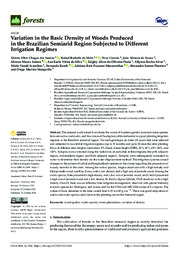Variation in the Basic Density of Woods Produced in the Brazilian Semiarid Region Subjected to Different Irrigation Regimes.
Variation in the Basic Density of Woods Produced in the Brazilian Semiarid Region Subjected to Different Irrigation Regimes.
Autoria: SANTOS, M. E. C. DOS; MELO, R. R. DE; CORREIA, D.; SOUSA, J. A. de; SANTOS, A. M.; SILVA, A. K. V. DA; PAULA, E. A. DE O.; ALVES, A. R.; SCATOLINO, M. V.; RUSCH, F.; MASCARENHAS, A. R. P.; PIMENTA, A. S.; STANGERLIN, D. M.
Resumo: Abstract: The present work aimed to evaluate the wood of fourteen genetic materials (nine species, between native and exotic, and five clones of Eucalyptus) cultivated under two post-planting irrigation regimes in the Brazilian semiarid region. For each genotype, six trees (11 years old) were selected and subjected to two initial irrigation regimes (up to 12 months and up to 36 months) after planting. Discs of different stem heights were taken: 0% (base), breast height (DBH), 20%, 40%, 60%, 80%, and 100%. Samples were extracted along the radial axis of each disk at three regions (the pith-adjacent region, intermediate region, and bark-adjacent region). Samples were subsequently saturated in water to determine their density via the water displacement method. The irrigation systems caused changes in the pattern of radial and longitudinal variation in the clones regarding the proportion of woody material in the stem. Among the native species, Angico stood out with a high density and little juvenile wood, and Pau d’arco, with a low density and a high rate of juvenile wood. Among the exotic species, Nim presented a high density and a low rate of juvenile wood, and Chichá presented a high rate of juvenile wood and a low density. In the Eucalyptus hybrids, VE38 stood out with a high density. Overall, there was an influence from irrigation management, observed with greater intensity in exotic species for Mahogany and Acacia and for the VE41 and AEC1528 clones of Eucalyptus. The values of basic densities in the trees varied from 0.35 to 0.85 g·cm?3. There was good adaptation of native and exotic species and clones to the planting area in the Semiarid region.
Ano de publicação: 2023
Tipo de publicação: Artigo de periódico
Unidade: Embrapa Agroindústria Tropical
Observações
1 - Por padrão são exibidas publicações dos últimos 20 anos. Para encontrar publicações mais antigas, configure o filtro ano de publicação, colocando o ano a partir do qual você deseja encontrar publicações. O filtro está na coluna da esquerda na busca acima.
2 - Para ler algumas publicações da Embrapa (apenas as que estão em formato ePub), é necessário ter, no celular ou computador, um desses softwares gratuitos. Sistemas Android: Google Play Livros; IOS: iBooks; Windows e Linux: software Calibre.
Acesse outras publicações
Acesse a Base de Dados da Pesquisa Agropecuária (BDPA) para consultar o acervo completo das bibliotecas da Embrapa.

